Hongteng Xu
MoORE: SVD-based Model MoE-ization for Conflict- and Oblivion-Resistant Multi-Task Adaptation
Jun 17, 2025Abstract:Adapting large-scale foundation models in multi-task scenarios often suffers from task conflict and oblivion. To mitigate such issues, we propose a novel ''model MoE-ization'' strategy that leads to a conflict- and oblivion-resistant multi-task adaptation method. Given a weight matrix of a pre-trained model, our method applies SVD to it and introduces a learnable router to adjust its singular values based on tasks and samples. Accordingly, the weight matrix becomes a Mixture of Orthogonal Rank-one Experts (MoORE), in which each expert corresponds to the outer product of a left singular vector and the corresponding right one. We can improve the model capacity by imposing a learnable orthogonal transform on the right singular vectors. Unlike low-rank adaptation (LoRA) and its MoE-driven variants, MoORE guarantees the experts' orthogonality and maintains the column space of the original weight matrix. These two properties make the adapted model resistant to the conflicts among the new tasks and the oblivion of its original tasks, respectively. Experiments on various datasets demonstrate that MoORE outperforms existing multi-task adaptation methods consistently, showing its superiority in terms of conflict- and oblivion-resistance. The code of the experiments is available at https://github.com/DaShenZi721/MoORE.
PolyConf: Unlocking Polymer Conformation Generation through Hierarchical Generative Models
Apr 11, 2025Abstract:Polymer conformation generation is a critical task that enables atomic-level studies of diverse polymer materials. While significant advances have been made in designing various conformation generation methods for small molecules and proteins, these methods struggle to generate polymer conformations due to polymers' unique structural characteristics. The scarcity of polymer conformation datasets further limits progress, making this promising area largely unexplored. In this work, we propose PolyConf, a pioneering tailored polymer conformation generation method that leverages hierarchical generative models to unlock new possibilities for this task. Specifically, we decompose the polymer conformation into a series of local conformations (i.e., the conformations of its repeating units), generating these local conformations through an autoregressive model. We then generate corresponding orientation transformations via a diffusion model to assemble these local conformations into the complete polymer conformation. Moreover, we develop the first benchmark with a high-quality polymer conformation dataset derived from molecular dynamics simulations to boost related research in this area. The comprehensive evaluation demonstrates that PolyConf consistently generates high-quality polymer conformations, facilitating advancements in polymer modeling and simulation.
Learning Structure-enhanced Temporal Point Processes with Gromov-Wasserstein Regularization
Mar 29, 2025



Abstract:Real-world event sequences are often generated by different temporal point processes (TPPs) and thus have clustering structures. Nonetheless, in the modeling and prediction of event sequences, most existing TPPs ignore the inherent clustering structures of the event sequences, leading to the models with unsatisfactory interpretability. In this study, we learn structure-enhanced TPPs with the help of Gromov-Wasserstein (GW) regularization, which imposes clustering structures on the sequence-level embeddings of the TPPs in the maximum likelihood estimation framework.In the training phase, the proposed method leverages a nonparametric TPP kernel to regularize the similarity matrix derived based on the sequence embeddings. In large-scale applications, we sample the kernel matrix and implement the regularization as a Gromov-Wasserstein (GW) discrepancy term, which achieves a trade-off between regularity and computational efficiency.The TPPs learned through this method result in clustered sequence embeddings and demonstrate competitive predictive and clustering performance, significantly improving the model interpretability without compromising prediction accuracy.
ReQFlow: Rectified Quaternion Flow for Efficient and High-Quality Protein Backbone Generation
Feb 20, 2025Abstract:Protein backbone generation plays a central role in de novo protein design and is significant for many biological and medical applications. Although diffusion and flow-based generative models provide potential solutions to this challenging task, they often generate proteins with undesired designability and suffer computational inefficiency. In this study, we propose a novel rectified quaternion flow (ReQFlow) matching method for fast and high-quality protein backbone generation. In particular, our method generates a local translation and a 3D rotation from random noise for each residue in a protein chain, which represents each 3D rotation as a unit quaternion and constructs its flow by spherical linear interpolation (SLERP) in an exponential format. We train the model by quaternion flow (QFlow) matching with guaranteed numerical stability and rectify the QFlow model to accelerate its inference and improve the designability of generated protein backbones, leading to the proposed ReQFlow model. Experiments show that ReQFlow achieves state-of-the-art performance in protein backbone generation while requiring much fewer sampling steps and significantly less inference time (e.g., being 37x faster than RFDiffusion and 62x faster than Genie2 when generating a backbone of length 300), demonstrating its effectiveness and efficiency. The code is available at https://github.com/AngxiaoYue/ReQFlow.
A Plug-and-Play Bregman ADMM Module for Inferring Event Branches in Temporal Point Processes
Jan 08, 2025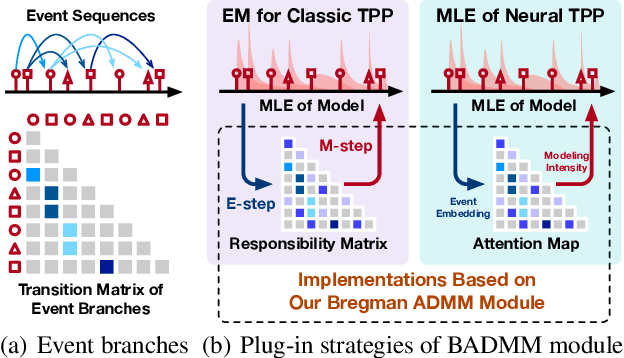

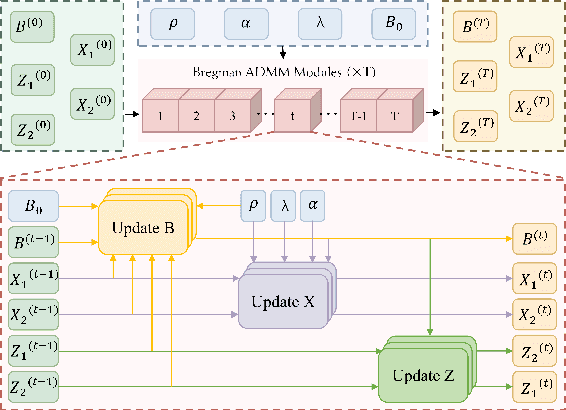

Abstract:An event sequence generated by a temporal point process is often associated with a hidden and structured event branching process that captures the triggering relations between its historical and current events. In this study, we design a new plug-and-play module based on the Bregman ADMM (BADMM) algorithm, which infers event branches associated with event sequences in the maximum likelihood estimation framework of temporal point processes (TPPs). Specifically, we formulate the inference of event branches as an optimization problem for the event transition matrix under sparse and low-rank constraints, which is embedded in existing TPP models or their learning paradigms. We can implement this optimization problem based on subspace clustering and sparse group-lasso, respectively, and solve it using the Bregman ADMM algorithm, whose unrolling leads to the proposed BADMM module. When learning a classic TPP (e.g., Hawkes process) by the expectation-maximization algorithm, the BADMM module helps derive structured responsibility matrices in the E-step. Similarly, the BADMM module helps derive low-rank and sparse attention maps for the neural TPPs with self-attention layers. The structured responsibility matrices and attention maps, which work as learned event transition matrices, indicate event branches, e.g., inferring isolated events and those key events triggering many subsequent events. Experiments on both synthetic and real-world data show that plugging our BADMM module into existing TPP models and learning paradigms can improve model performance and provide us with interpretable structured event branches. The code is available at \url{https://github.com/qingmeiwangdaily/BADMM_TPP}.
Conservation-informed Graph Learning for Spatiotemporal Dynamics Prediction
Dec 30, 2024



Abstract:Data-centric methods have shown great potential in understanding and predicting spatiotemporal dynamics, enabling better design and control of the object system. However, pure deep learning models often lack interpretability, fail to obey intrinsic physics, and struggle to cope with the various domains. While geometry-based methods, e.g., graph neural networks (GNNs), have been proposed to further tackle these challenges, they still need to find the implicit physical laws from large datasets and rely excessively on rich labeled data. In this paper, we herein introduce the conservation-informed GNN (CiGNN), an end-to-end explainable learning framework, to learn spatiotemporal dynamics based on limited training data. The network is designed to conform to the general conservation law via symmetry, where conservative and non-conservative information passes over a multiscale space enhanced by a latent temporal marching strategy. The efficacy of our model has been verified in various spatiotemporal systems based on synthetic and real-world datasets, showing superiority over baseline models. Results demonstrate that CiGNN exhibits remarkable accuracy and generalization ability, and is readily applicable to learning for prediction of various spatiotemporal dynamics in a spatial domain with complex geometry.
Efficient Video Face Enhancement with Enhanced Spatial-Temporal Consistency
Nov 25, 2024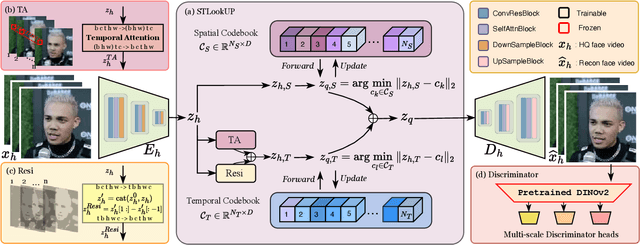



Abstract:As a very common type of video, face videos often appear in movies, talk shows, live broadcasts, and other scenes. Real-world online videos are often plagued by degradations such as blurring and quantization noise, due to the high compression ratio caused by high communication costs and limited transmission bandwidth. These degradations have a particularly serious impact on face videos because the human visual system is highly sensitive to facial details. Despite the significant advancement in video face enhancement, current methods still suffer from $i)$ long processing time and $ii)$ inconsistent spatial-temporal visual effects (e.g., flickering). This study proposes a novel and efficient blind video face enhancement method to overcome the above two challenges, restoring high-quality videos from their compressed low-quality versions with an effective de-flickering mechanism. In particular, the proposed method develops upon a 3D-VQGAN backbone associated with spatial-temporal codebooks recording high-quality portrait features and residual-based temporal information. We develop a two-stage learning framework for the model. In Stage \Rmnum{1}, we learn the model with a regularizer mitigating the codebook collapse problem. In Stage \Rmnum{2}, we learn two transformers to lookup code from the codebooks and further update the encoder of low-quality videos. Experiments conducted on the VFHQ-Test dataset demonstrate that our method surpasses the current state-of-the-art blind face video restoration and de-flickering methods on both efficiency and effectiveness. Code is available at \url{https://github.com/Dixin-Lab/BFVR-STC}.
A Bayesian Mixture Model of Temporal Point Processes with Determinantal Point Process Prior
Nov 07, 2024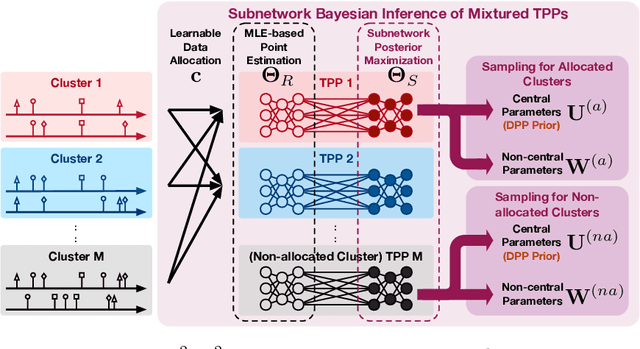

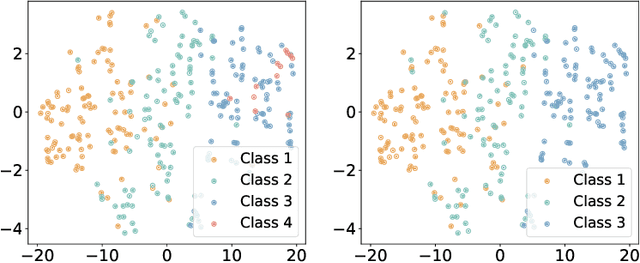
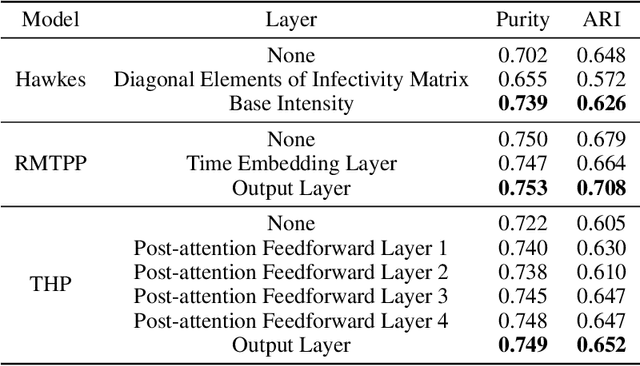
Abstract:Asynchronous event sequence clustering aims to group similar event sequences in an unsupervised manner. Mixture models of temporal point processes have been proposed to solve this problem, but they often suffer from overfitting, leading to excessive cluster generation with a lack of diversity. To overcome these limitations, we propose a Bayesian mixture model of Temporal Point Processes with Determinantal Point Process prior (TP$^2$DP$^2$) and accordingly an efficient posterior inference algorithm based on conditional Gibbs sampling. Our work provides a flexible learning framework for event sequence clustering, enabling automatic identification of the potential number of clusters and accurate grouping of sequences with similar features. It is applicable to a wide range of parametric temporal point processes, including neural network-based models. Experimental results on both synthetic and real-world data suggest that our framework could produce moderately fewer yet more diverse mixture components, and achieve outstanding results across multiple evaluation metrics.
Towards Better Multi-head Attention via Channel-wise Sample Permutation
Oct 14, 2024



Abstract:Transformer plays a central role in many fundamental deep learning models, e.g., the ViT in computer vision and the BERT and GPT in natural language processing, whose effectiveness is mainly attributed to its multi-head attention (MHA) mechanism. In this study, we propose a simple and novel channel-wise sample permutation (CSP) operator, achieving a new structured MHA with fewer parameters and lower complexity. Given an input matrix, CSP circularly shifts the samples of different channels with various steps and then sorts grouped samples of each channel. This operator is equivalent to implicitly implementing cross-channel attention maps as permutation matrices, which achieves linear complexity and suppresses the risk of rank collapse when representing data. We replace the MHA of some representative models with CSP and test the CSP-based models in several discriminative tasks, including image classification and long sequence analysis. Experiments show that the CSP-based models achieve comparable or better performance with fewer parameters and lower computational costs than the classic Transformer and its state-of-the-art variants. The code is available at https://github.com/DaShenZi721/CSP.
Predicting Molecular Ground-State Conformation via Conformation Optimization
Oct 13, 2024



Abstract:Predicting ground-state conformation from the corresponding molecular graph is crucial for many chemical applications, such as molecular modeling, molecular docking, and molecular property prediction. Recently, many learning-based methods have been proposed to replace time-consuming simulations for this task. However, these methods are often inefficient and sub-optimal as they merely rely on molecular graph information to make predictions from scratch. In this work, considering that molecular low-quality conformations are readily available, we propose a novel framework called ConfOpt to predict molecular ground-state conformation from the perspective of conformation optimization. Specifically, ConfOpt takes the molecular graph and corresponding low-quality 3D conformation as inputs, and then derives the ground-state conformation by iteratively optimizing the low-quality conformation under the guidance of the molecular graph. During training, ConfOpt concurrently optimizes the predicted atomic 3D coordinates and the corresponding interatomic distances, resulting in a strong predictive model. Extensive experiments demonstrate that ConfOpt significantly outperforms existing methods, thus providing a new paradigm for efficiently and accurately predicting molecular ground-state conformation.
 Add to Chrome
Add to Chrome Add to Firefox
Add to Firefox Add to Edge
Add to Edge